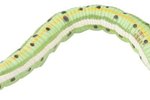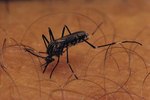
Honey bees (Apis mellifera) are highly social insects who live in dense colonies. For this reason, they require a sophisticated set of senses for communication. They also use their senses for food and threat detection. The majority of bees' sensory organs are located in the antennae. This is the first part of the bee to come into contact with scent, flavor and the physical world. Aside from the antennae, their hairs are highly useful for making sense of the world around them.
Olfactory Antennae
Honey bees use their antennae to detect odor. According to research by the National Institutes of Health, published in the "Genome Research" journal, honey bees have 170 odor receptors, or chemoreceptors, in their antennae. This is high for an insect -- fruit flies (Drosophila melanogaster) have 62 receptors and mosquitos (Anopheles gambiae) have 79. The honey bee’s sense of smell is so sensitive that it can detect the trace of a scent in flight. This ability equips the bee to effectively and efficiently locate pollen-rich flowers. Once the scent is detected on the antennae, the bee’s hyper-sensitive olfactory path processes the information, enabling the bee to determine the relevance of the scent to her search for pollen. As well as for finding food, honey bees use their sense of smell to locate other bees.
Unsophisticated Sense of Taste
In contrast to their highly developed sense of smell, the bee’s sense of taste is somewhat basic. They use their tongues, which contain taste buds, to detect sweet, sour, bitter and sweet -- the same range of taste detection that humans use -- but since they gather lots of information from smell, enabling them to taste before the pollen touches the tongue, they’ve effectively done all of the research necessary before the sustenance reaches their mouths. Since bees provide benefit to plants, by means of pollination, plants have not evolved any defense mechanisms against bees. This means that no plants produce distasteful or harmful pollen.
A Physical Width Gauge
The antennae can gauge dimensions. When a bee’s antennae touch an object, for example the inside of a honey comb, they can figure out the depth and width. This helps them to construct consistently sized honeycomb cells. The ability of the antennae to sense touch is also useful for communication; bees use touch to communicate with one another during bee dances. When the antennae touch an object, a bee may stick out his tongue in order to taste it.
Sensitive Hairs
Bees are covered in tiny hairs, each with a nerve at the base. These hairs are sensitive to vibration; if they detect an unfamiliar vibration frequency, the bee will become alarmed. Bees also use these hairs for touch. If they're physically touched, the nerves send a message to the bee’s brain, alerting it that it is being touched.
References
Photo Credits
-
Duncan Smith/Digital Vision/Getty Images
Writer Bio
Simon Foden has been a freelance writer and editor since 1999. He began his writing career after graduating with a Bachelors of Arts degree in music from Salford University. He has contributed to and written for various magazines including "K9 Magazine" and "Pet Friendly Magazine." He has also written for Dogmagazine.net.



